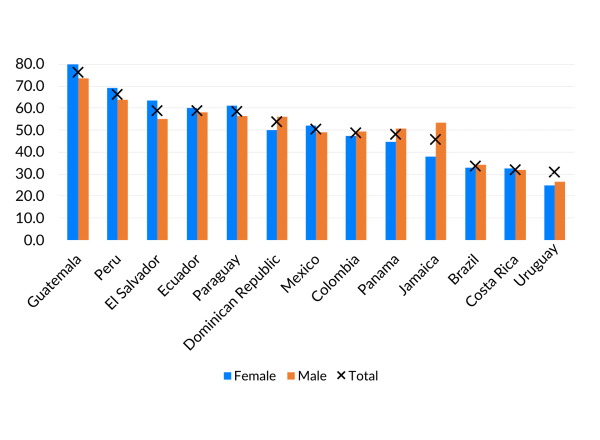
As described in our recent report, female workers are a critical yet underutilized resource across Latin America’s major economies. Expanding women’s labor force participation to the rates of Nordic countries could result in substantial economic gains throughout the region—up to $208.8 billion in Mexico alone. Yet, Latin American women face steep barriers to employment, largely due to structural and cultural challenges that lead many female workers to resort to informal employment.
The roots of high rates of informal work in emerging and developing economies vary across regions, with heavy regulation and weak institutions playing a role in Latin America, as reported by the World Bank Group. Rapid urban growth has also contributed to high informality rates. Since the 1960s, CepalStat reports, Latin America has shifted from an even rural-urban split to more than 80 percent of its population living in urban areas. According to a Geography Compass article, formal job creation in Latin American cities did not keep up with the rapid population growth resulting from accelerated urbanization, leaving many workers—particularly women—trapped in jobs without essential benefits or protections.
According to the United Nations’ branch promoting women's rights, women comprise about 60 percent of the informal workforce in Latin American countries. Moreover, informal employment is more prevalent among female than male workers in the Latin American countries where informality is most widespread (Figure 1). In six of the seven Latin American countries where more than half of the labor force is employed informally, women are more likely than men to be working in informal work arrangements. This includes Mexico, the region’s second-largest economy and the US’s largest trading partner, where more than 13.5 million women were employed informally in 2023.
Figure 1. Rates of Informal Work in Latin America, by Gender (2023)

Source: Authors’ analysis using data from ILOSTAT
Gender inequities in how work is valued and compensated expose women to time constraints that force them to seek flexible informal work arrangements. The United Nations Development Programme states that women carry about three-fourths of the burden of unpaid care work in most Latin American countries, with female unpaid work valued at approximately 21.4 percent of the region’s gross domestic product. Overreliance on women’s unpaid work limits their entry into formal labor markets. High costs and limited availability of childcare services aggravate this problem, leading many highly skilled Latin American women to take up informal work, which not only exposes them to unstable working arrangements but also limits their economic potential.
Taking Mexico as an example, Mexican women are more likely to experience informality than men at all schooling levels, but the gap widens among those with higher education. Women with advanced research qualifications are 11 percent more likely to work informally than their male counterparts in Mexico (Figure 2). In 2023, over 1.4 million Mexican women with advanced education were employed informally, according to data from the International Labour Organization. Incorporating these women into formal work would have substantial productivity and fiscal gains for the country’s economy, in addition to offering formal protections to these women who are otherwise exposed to the hazards that accompany informal work.
Figure 2: Percent Difference in the Likelihood of Women and Men Working Informally (Mexico, 2023)

Source: Authors’ analysis using data from ILOSTAT
TecScience reports that Latin American women are highly entrepreneurial, with female-owned small and medium enterprises (SMEs) creating 67 percent of the region’s jobs. Yet, women receive limited support to establish and sustain their businesses in the region. Over 80 percent of women who start businesses do so out of necessity, according to a Pro Mujer article, often having to resort to the informal sector, where they face gender-specific obstacles. Many rely on microcredit, though these loans typically provide less funding than is needed for business growth. The International Finance Corporation estimates a $5 billion funding gap for women-led micro-enterprises and an even larger $93 billion deficit for their SMEs, according to a World Bank report.
Increasing access to and affordability of childcare, along with flexible work policies, could facilitate higher formal workforce participation among women in Latin America. While the impact of childcare on employment can vary across contexts, evidence from Latin American countries supports the effectiveness of childcare in increasing female formal work. Based on findings in a Science Direct report, in Chile, for example, access to afterschool childcare programs for school-age children increased female labor force participation and employment outcomes by 4.3 and 3.4 percent, respectively.
Ultimately, a one-size-fits-all approach cannot address the complex challenges women face in Latin America’s urban informal sector. Simply increasing work opportunities without raising female wages or providing affordable childcare risks pushing more women into informal work, perpetuating cycles of vulnerability. Effective policies must be gender-sensitive and responsive to local labor market dynamics, focusing on structural issues that limit women’s opportunities for economic security. Addressing critical gaps in financial inclusion, contract enforcement, and access to affordable childcare can create pathways for women to move into more stable forms of employment.
As highlighted by PBS SoCal, recognizing the informal sector as a persistent feature of modern economies—rather than a relic of “pre-modern” capitalism—can help policymakers target it as a key site of labor and economic exploitation. By framing wage work as a spectrum between formality and informality, policies can better address the structural conditions limiting economic security for women in the informal sector. Targeted policies can reduce the gender productivity gap and help women move toward more stable forms of employment, according to a Science Direct report. Such efforts would improve financial security for women and their families while fostering more resilient economies across Latin America.











